Yamaha CVP-309 User Manual

C V P - 3 0 9 / 3 0 7
O W N E R ’ S |
M A N U A L |
I M P O R T A N T — C h e c k y o u r p o w e r s u p p l y —
Make sure that your local AC mains voltage matches the voltage specified on the name plate on the bottom panel. In some areas a voltage selector may be provided on the bottom panel of the main keyboard unit near the power cord. Make sure that the voltage selector is set for the voltage in your area. The voltage selector is set at 240V when the unit is initially shipped. To change the setting use a "minus" screwdriver to rotate the selector dial so that the correct voltage appears next to the pointer on the panel.
 For information on assembling the keyboard stand, refer to the instructions at the end of this manual.
For information on assembling the keyboard stand, refer to the instructions at the end of this manual.

SPECIAL MESSAGE SECTION
PRODUCT SAFETY MARKINGS: Yamaha electronic products may have either labels similar to the graphics shown below or molded/stamped facsimiles of these graphics on the enclosure. The explanation of these graphics appears on this page. Please observe all cautions indicated on this page and those indicated in the safety instruction section.
CAUTION |
RISK OF ELECTRIC SHOCK |
DO NOT OPEN |
CAUTION: TO REDUCE THE RISK OF ELECTRIC SHOCK. |
DO NOT REMOVE COVER (OR BACK). |
NO USER-SERVICEABLE PARTS INSIDE. |
REFER SERVICING TO QUALIFIED SERVICE PERSONNEL. |
See bottom of Keyboard enclosure for graphic symbol markings.
The exclamation point within the equilateral triangle is intended to alert the user to the presence of important operating and maintenance (servicing) instructions in the literature accompanying the product.
The lightning flash with arrowhead symbol, within the equilateral triangle, is intended to alert the user to the presence of uninsulated “dangerous voltage” within the product’s enclosure that may be of sufficient magnitude to constitute a risk of electrical shock.
IMPORTANT NOTICE: All Yamaha electronic products are tested and approved by an independent safety testing laboratory in order that you may be sure that when it is properly installed and used in its normal and customary manner, all foreseeable risks have been eliminated. DO NOT modify this unit or commission others to do so unless specifically authorized by Yamaha. Product performance and/or safety standards may be diminished. Claims filed under the expressed warranty may be denied if the unit is/has been modified. Implied warranties may also be affected.
SPECIFICATIONS SUBJECT TO CHANGE: The information contained in this manual is believed to be correct at the time of printing. However, Yamaha reserves the right to change or modify any of the specifications without notice or obligation to update existing units.
ENVIRONMENTAL ISSUES: Yamaha strives to produce products that are both user safe and environmentally friendly. We sincerely believe that our products and the production methods used to produce them, meet these goals. In keeping with both the letter and the spirit of the law, we want you to be aware of the following:
Battery Notice: This product MAY contain a small nonrechargable battery which (if applicable) is soldered in place. The average life span of this type of battery is approximately five years. When replacement becomes necessary, contact a qualified service representative to perform the replacement.
Warning: Do not attempt to recharge, disassemble, or incinerate this type of battery. Keep all batteries away from children. Dispose of used batteries promptly and as regulated by applicable laws. Note: In some areas, the servicer is required by law to return the defective parts. However, you do have the option of having the servicer dispose of these parts for you.
Disposal Notice: Should this product become damaged beyond repair, or for some reason its useful life is considered to be at an end, please observe all local, state, and federal regulations that relate to the disposal of products that contain lead, batteries, plastics, etc.
NOTICE: Service charges incurred due to lack of knowledge relating to how a function or effect works (when the unit is operating as designed) are not covered by the manufacturer’s warranty, and are therefore the owners responsibility. Please study this manual carefully and consult your dealer before requesting service.
NAME PLATE LOCATION: The graphic below indicates the location of the name plate. The model number, serial number, power requirements, etc., are located on this plate. You should record the model number, serial number, and the date of purchase in the spaces provided below and retain this manual as a permanent record of your purchase.
CVP-309 |
|
(grand piano type) |
CVP-309/307 |
Model
Serial No.
Purchase Date
92-469 1 (bottom)
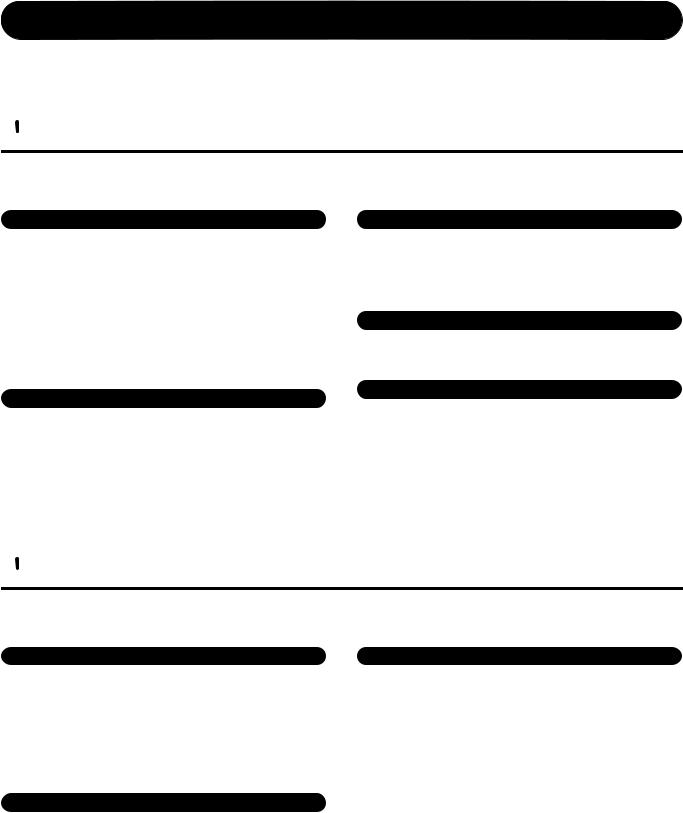
PRECAUTIONS
PLEASE READ CAREFULLY BEFORE PROCEEDING
* Please keep this manual in a safe place for future reference.
 WARNING
WARNING
Always follow the basic precautions listed below to avoid the possibility of serious injury or even death from electrical shock, short-circuiting, damages, fire or other hazards. These precautions include, but are not limited to, the following:
Power supply/Power cord
•Only use the voltage specified as correct for the instrument. The required voltage is printed on the name plate of the instrument.
•Check the electric plug periodically and remove any dirt or dust which may have accumulated on it.
•Use only the supplied power cord/plug.
•Do not place the power cord near heat sources such as heaters or radiators, and do not excessively bend or otherwise damage the cord, place heavy objects on it, or place it in a position where anyone could walk on, trip over, or roll anything over it.
Water warning
•Do not expose the instrument to rain, use it near water or in damp or wet conditions, or place containers on it containing liquids which might spill into any openings.
•Never insert or remove an electric plug with wet hands.
Fire warning
•Do not put burning items, such as candles, on the unit. A burning item may fall over and cause a fire.
Do not open
•Do not open the instrument or attempt to disassemble the internal parts or modify them in any way. The instrument contains no user-serviceable parts. If it should appear to be malfunctioning, discontinue use immediately and have it inspected by qualified Yamaha service personnel.
If you notice any abnormality
•If the power cord or plug becomes frayed or damaged, or if there is a sudden loss of sound during use of the instrument, or if any unusual smells or smoke should appear to be caused by it, immediately turn off the power switch, disconnect the electric plug from the outlet, and have the instrument inspected by qualified Yamaha service personnel.
 CAUTION
CAUTION
Always follow the basic precautions listed below to avoid the possibility of physical injury to you or others, or damage to the instrument or other property. These precautions include, but are not limited to, the following:
Power supply/Power cord |
|
Location |
•When removing the electric plug from the instrument or an outlet, always hold the plug itself and not the cord. Pulling by the cord can damage it.
•Remove the electric plug from the outlet when the instrument is not to be used for extended periods of time, or during electrical storms.
•Do not connect the instrument to an electrical outlet using a multiple-connector. Doing so can result in lower sound quality, or possibly cause overheating in the outlet.
Assembly
•Read carefully the attached documentation explaining the assembly process. Failure to assemble the instrument in the proper sequence might result in damage to the instrument or even injury.
•Do not expose the instrument to excessive dust or vibrations, or extreme cold or heat (such as in direct sunlight, near a heater, or in a car during the day) to prevent the possibility of panel disfiguration or damage to the internal components.
•Do not use the instrument in the vicinity of a TV, radio, stereo equipment, mobile phone, or other electric devices. Otherwise, the instrument, TV, or radio may generate noise.
•Do not place the instrument in an unstable position where it might accidentally fall over.
•Before moving the instrument, remove all connected cables.
(1)B-7 1/2
CVP-309/307 Owner’s Manual |
3 |
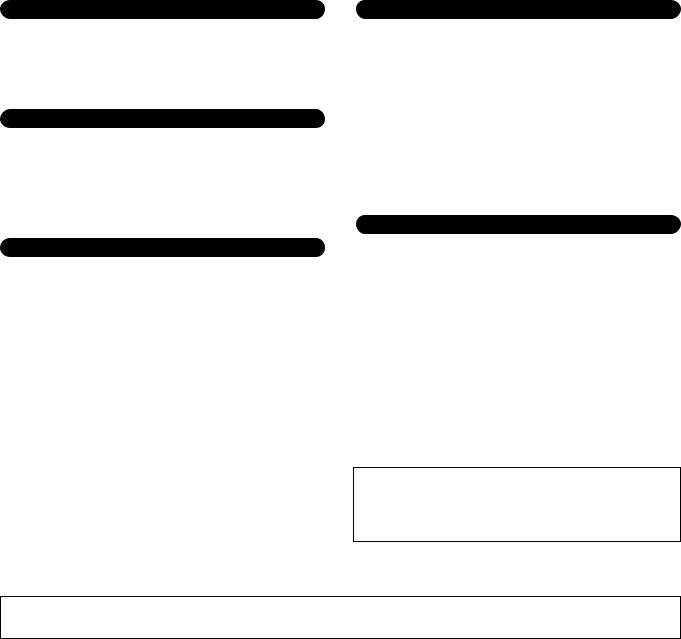
Connections
•Before connecting the instrument to other electronic components, turn off the power for all components. Before turning the power on or off for all components, set all volume levels to minimum. Also, be sure to set the volumes of all components at their minimum levels and gradually raise the volume controls while playing the instrument to set the desired listening level.
Maintenance
•(CVP-309 including grand piano type) Gently remove dust and dirt with a soft cloth. Do not wipe too hard since small particles of dirt can scratch the instrument's finish.
•When cleaning the instrument, use a soft, dry or slightly damp cloth. Do not use paint thinners, solvents, cleaning fluids, or chemical-impregnated wiping cloths.
Handling caution
•Take care that the key cover does not pinch your fingers, and do not insert a finger or hand in any gaps on the key cover or instrument.
•Never insert or drop paper, metallic, or other objects into the gaps on the key cover, panel or keyboard. If this happens, turn off the power immediately and unplug the power cord from the AC outlet. Then have the instrument inspected by qualified Yamaha service personnel.
•Do not place vinyl, plastic or rubber objects on the instrument, since this might discolor the panel or keyboard.
•(CVP-309 including grand piano type) Bumping the surface of the instrument with metal, porcelain, or other hard objects can cause the finish to crack or peel. Use caution.
•Do not rest your weight on, or place heavy objects on the instrument, and do not use excessive force on the buttons, switches or connectors.
•Do not operate the instrument for a long period of time at a high or uncomfortable volume level, since this can cause permanent hearing loss. If you experience any hearing loss or ringing in the ears, consult a physician.
Using the bench (If included)
•Do not place the bench in an unstable position where it might accidentally fall over.
•Do not play carelessly with or stand on the bench. Using it as a tool or stepladder or for any other purpose might result in accident or injury.
•Only one person should sit on the bench at a time, in order to prevent the possibility of accident or injury.
•(CVP-309 including grand piano type) Do not attempt to adjust the bench height while sitting on the bench, since this can cause excessive force to be imposed on the adjustment mechanism, possibly resulting in damage to the mechanism or even injury.
•If the bench screws become loose due to extensive long-term use, tighten them periodically using the included tool.
Saving data
Saving and backing up your data
•The data of the types listed below are lost when you turn off the power to the instrument. Save the data to the USER tab display (page 26), floppy disk, SmartMedia card, or appropriate external media.
•Recorded/Edited Songs (page 41, 137, 152)
•Created/Edited Styles (page 111)
•Edited Voices (page 93)
•Memorized One Touch Settings (page 50)
•Edited MIDI settings (page 196)
Data in the USER tab display (page 26) may be lost due to malfunction or incorrect operation. Save important data to a floppy disk, SmartMedia card, or external media.
When you change settings in a display page and then exit from that page, System Setup data (listed in the Parameter Chart of the separate Data List booklet) is automatically stored. However, this edited data is lost if you turn off the power without properly exiting from the relevant display.
Yamaha cannot be held responsible for damage caused by improper use or modifications to the instrument, or data that is lost or destroyed.
Always turn the power off when the instrument is not in use.
(1)B-7 2/2
4 |
CVP-309/307 Owner’s Manual |
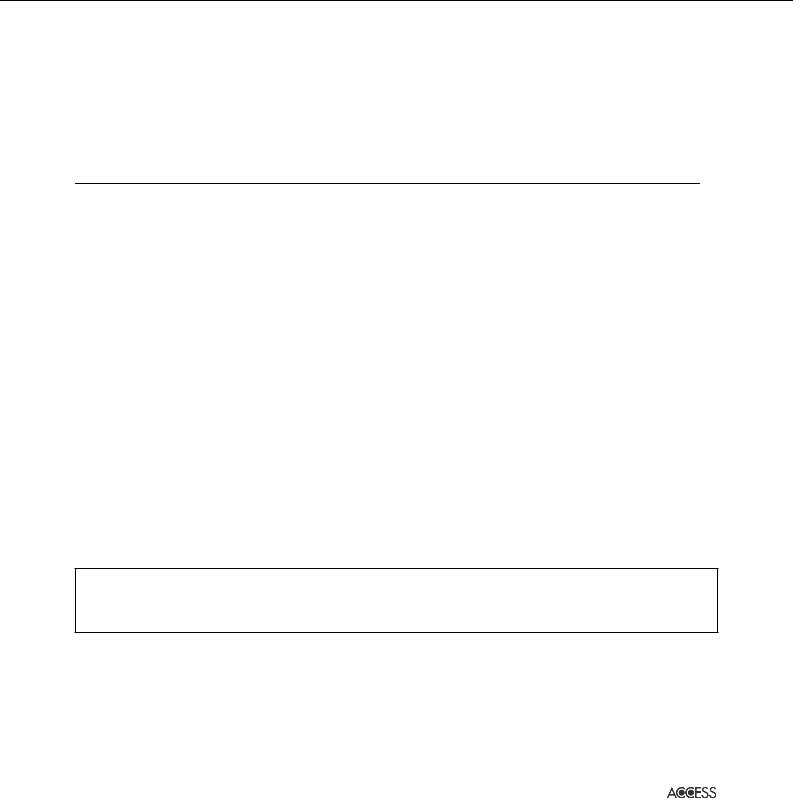
Thank you for purchasing this Yamaha Clavinova!
We recommend that you read this manual carefully so that you can fully take advantage of the advanced and convenient functions of the Clavinova.
We also recommend that you keep this manual in a safe and handy place for future reference.
About this Owner’s Manual and Data List
This manual consists of the following sections.
Owner’s Manual
Introduction (page 12).......................... |
Please read this section first. |
Quick Guide (page 23)......................... |
This section explains how to use the basic functions. |
Basic Operation (page 57).................... |
This section explains how to use the basic operations including display- |
|
based controls. |
Reference (page 72) ............................. |
This section explains how to make detailed settings for the Clavinova’s |
|
various functions. |
Appendix (page 201)............................ |
This section contains additional information such as Troubleshooting and |
|
Specifications. |
Data List
Voice List, MIDI Data Format, etc.
•The models CVP-309/307 will be referred to as the CVP/Clavinova in this Owner’s Manual.
•The illustrations and LCD screens as shown in this owner’s manual are for instructional purposes only, and may appear somewhat different from those on your instrument.
•The example Operation Guide displays shown in this Manual are in English.
•Copying of the commercially available software is strictly prohibited except for your personal use.
This product incorporates and bundles computer programs and contents in which Yamaha owns copyrights or with respect to which it has license to use others’ copyrights. Such copyrighted materials include, without limitation, all computer software, style files, MIDI files, WAVE data and sound recordings. Any unauthorized use of such programs and contents outside of personal use is not permitted under relevant laws. Any violation of copyright has legal consequences. DON’T MAKE, DISTRIBUTE OR USE ILLEGAL COPIES.
•The photos of the harpsichord, bandoneon, hackbrett, music box, dulcimer and cimbalom, shown in the displays of the CVP-309/307, are courtesy of the Gakkigaku Shiryokan (Collection for Organolgy), Kunitachi College of Music.
•The following instruments, shown in the displays of the CVP-309/307, are on display at the Hamamatsu Museum of Musical Instruments: balafon, gender, kalimba, kanoon, santur, gamelan gong, harp, hand bell, bagpipe, banjo, carillon, mandolin, oud, pan flute, pungi, rabab, shanai, sitar, steel drum, and tambra.
•This product is manufactured under license of U.S. Patents No.5231671, No.5301259, No.5428708, and No.5567901 from IVL Technologies Ltd.
•The bitmap fonts used in this instrument have been provided by and are the property of Ricoh Co., Ltd.
•This product utilizes NF, an embedded Internet browser from ACCESS Co., Ltd. NF is used with the patented LZW, licensed
from Unisys Co., Ltd. NF may not be separated from this product, nor may it be sold, lent or transferred in any way. Also, NF may not be reverse-engineered, reverse-compiled, reverse-assembled or copied.
This software includes a module developed by the Independent JPEG Group.
Trademarks:
•Apple and Macintosh are trademarks of Apple Computer, Inc.
•Windows is the registered trademark of Microsoft® Corporation.
•SmartMedia is a trademark of Toshiba Corporation.
•All other trademarks are the property of their respective holders.
CVP-309/307 Owner’s Manual |
5 |
|
|

Accessories
Guide to Yamaha Online Member Product User Registration
“50 greats for the Piano” Music Book
Owner’s Manual
Data List
The following items may be included or optional, depending on your locale:
Floppy Disk Drive
SmartMedia card
Bench
■ Tuning
Unlike an acoustic piano, the Clavinova does not need to be tuned. It always stays perfectly in tune.
■ Transporting
If you move to another location, you can transport the Clavinova along with other belongings. You can move the unit as it is (assembled) or you can disassemble the unit down to the condition it was in when you first took it out of the box. Transport the keyboard horizontally. Do not lean it up against a wall or stand it up on its side.
Do not subject the instrument to excessive vibration or shock.
When transporting the assembled Clavinova, make sure all screws are properly tightened and have not been loosened by moving the instrument.
6 |
CVP-309/307 Owner’s Manual |
|
|

Table of Contents
Introduction |
|
Welcome to the Wonderful Musical World |
|
of the Clavinova CVP! ..................................... |
10 |
Panel Controls ................................................. |
12 |
Playing the Keyboard ...................................... |
14 |
Setting Up the Clavinova ................................ |
16 |
Music Rest ................................................... |
16 |
Sheet Music Braces ...................................... |
16 |
Lid (CVP-309 grand piano type).................... |
16 |
Using Headphones ....................................... |
17 |
Changing the Display Language .................. |
18 |
Display Settings ........................................... |
18 |
Handling the Floppy Disk Drive (FDD) and |
|
Floppy Disks .................................................... |
21 |
Handling SmartMediaTM*Memory Cards ......... |
22 |
Quick Guide |
|
Playing the Demos .......................................... |
23 |
Operations in the Basic Displays ..................... |
25 |
Operation of the Main Display ............................. |
25 |
Operation of the File Selection Display ................. |
25 |
Operation of the Function Display ........................ |
26 |
Playing Voices ................................................. |
28 |
Playing the Piano Voice ........................................ |
28 |
Playing Various Voices .......................................... |
31 |
Practicing with the Preset Songs .................... |
34 |
Playing Back Songs Before Practicing .................... |
34 |
One-handed Practice with the Guide Lamps ......... |
38 |
Practicing with the Repeat Playback Function ....... |
40 |
Recording Your Performance ................................ |
41 |
Playing Backing Parts with the performance |
|
assistant Technology ....................................... |
42 |
Playing Accompaniment with the Auto |
|
Accompaniment Feature (Style Playback) ...... |
44 |
Playing “Mary Had a Little Lamb” with the Auto |
|
Accompaniment Feature ...................................... |
44 |
Calling Up Ideal Setups for Each Song |
|
—Music Finder ................................................ |
50 |
Singing Along with Song Playback (Karaoke) |
|
or Your Own Performance .............................. |
52 |
Connecting a Microphone ................................... |
52 |
Singing with the Lyrics Display ............................. |
53 |
Convenient Functions for Karaoke ........................ |
53 |
Convenient Functions for Singing Along with Your |
|
Own Performance ................................................ |
55 |
Basic Operation |
|
Trying Out the Basic Features (Help) ............. |
57 |
The Messages Shown in the Display .............. |
57 |
Instant Selection of the Displays |
|
—Direct Access ................................................ |
58 |
Basic Displays (Main Display and File |
|
Selection Display) ............................................ |
59 |
Main Display ........................................................ |
59 |
File Selection Display Configuration and Basic |
|
Operation ............................................................. |
60 |
File/Folder Operations in the File Selection Display ... |
62 |
Restoring the Factory-programmed Settings ... |
69 |
Restoring the Factory-programmed System .......... |
69 |
Restoring the Factory-programmed Settings |
|
Independently by Item ......................................... |
69 |
Saving and Recalling Your Original Settings as a |
|
Single File ............................................................. |
70 |
Data Backup .................................................... |
71 |
Reference
Using, Creating and Editing Voices ..72
Voice Characteristics ....................................... |
72 |
Playing Different Voices Simultaneously ........ |
73 |
Keyboard Parts (Right 1, Right 2, Left) .................. |
73 |
Playing Two Voices Simultaneously |
|
(Right 1 and 2 Parts) ............................................ |
74 |
Playing Different Voices with the Left and Right |
|
Hands (Right 1 and Left Parts) .............................. |
75 |
Enhancing the Acoustic Realism of the |
|
Sound (iAFC) ................................................... |
76 |
Selecting the iAFC Type and Adjusting the Depth . 76 |
|
Calibrating the iAFC Settings ................................ |
77 |
Changing Pitch ................................................ |
78 |
Transpose ............................................................. |
78 |
Fine-tuning the Pitch of the Entire Instrument ...... |
78 |
Scale Tuning ......................................................... |
78 |
Adding Effects to Voices Played on the |
|
Keyboard ......................................................... |
80 |
Editing the Volume and Tonal Balance |
|
(MIXING CONSOLE) ........................................ |
82 |
Basic Procedure .................................................... |
82 |
Voice Creating (Sound Creator) ..................... |
93 |
Basic Procedure .................................................... |
93 |
Creating Your Original Organ Flutes Voices .......... |
97 |
Various display pages and menus appear on the LCD display of this instrument, indicating the functions and operations. Throughout this manual, arrows are used in the instructions, indicating in shorthand the process of calling up these functions. The example shorthand below describes a four step operation:
1) press the [FUNCTION] button, 2) press the [D] button to select the Controller page, 3) press the TAB [®] button to select the Keyboard/Panel page, and 4) press the [A] button to select the Initial Touch parameter.
[FUNCTION] → [D] CONTROLLER → TAB [®] KEYBOARD/PANEL → [A] 1 INITIAL TOUCH
CVP-309/307 Owner’s Manual |
7 |
|
|

Using, Creating and Editing the |
|
Auto Accompaniment Styles .......... |
101 |
Style Characteristics ...................................... |
101 |
Selecting a Chord Fingering Type ................ |
101 |
Playing Only the Rhythm Channels of a |
|
Style ............................................................... |
102 |
Style Playback-related Settings ..................... |
104 |
Editing the Volume and Tonal Balance of |
|
the Style (MIXING CONSOLE) ...................... |
106 |
Convenient Music Finder feature ................. |
106 |
Searching the Records ........................................ |
106 |
Creating a Set of Favorite Records ...................... |
107 |
Editing Records .................................................. |
108 |
Saving the Record .............................................. |
109 |
Style Creator ................................................. |
111 |
Style Structure .................................................... |
111 |
Creating a Style .................................................. |
111 |
Editing the Created Style .................................... |
117 |
Registering and Recalling Custom |
|
Panel Setups—Registration |
|
Memory .......................................... |
125 |
Registering and Saving Custom Panel |
|
Setups ............................................................ |
125 |
Recalling the Registered Panel Setups ......... |
126 |
Deleting an Unneeded Panel Setup/Naming a |
|
Panel Setup ........................................................ |
127 |
Disabling Recall of Specific Items |
|
(Freeze Function) ............................................... |
127 |
Calling Up Registration Memory Numbers in |
|
Order—Registration Sequence ........................... |
128 |
Using, Creating and Editing |
|
Songs .............................................. |
130 |
Compatible Song Types ................................ |
130 |
Operations for Song Playback ...................... |
131 |
Adjusting the Volume Balance and Voice |
|
Combination, etc. (MIXING CONSOLE) ....... |
134 |
Using the Practice Function (Guide) ............ |
135 |
Selecting the Guide Function Type ..................... |
135 |
Recording Your Performance ....................... |
137 |
Recording Methods ............................................ |
137 |
Editing a Recorded Song .................................... |
152 |
Using a Microphone ....................... |
161 |
Editing Vocal Harmony Parameters .............. |
161 |
Adjusting the Microphone and Harmony |
|
Sound ............................................................ |
164 |
Talk Setting ................................................... |
168 |
Connecting the Clavinova Directly |
|
to the Internet ............................... |
170 |
Connecting the Instrument to the Internet . 170 |
|
Accessing the Special Clavinova Website ..... |
171 |
Operations in the Special Clavinova |
|
Website .......................................................... |
171 |
Scrolling the Display ........................................... |
171 |
Following Links ................................................... |
172 |
Entering Characters ............................................ |
172 |
Return to the Previous Web Page ........................ |
173 |
Refreshing a Web Page/Canceling Loading of a |
|
Web Page ........................................................... |
174 |
Purchasing and Downloading Data .................... |
174 |
Saving Bookmarks of Your Favorite Pages ........... |
175 |
Changing the Home Page .................................. |
178 |
About the Internet Settings Display .................... |
179 |
Initializing Internet Settings ................................ |
182 |
Glossary of Internet Terms ........................... |
183 |
Using Your Instrument with Other |
|
Devices ............................................ |
184 |
Using Headphones ([PHONES] jacks) ........... |
184 |
Connecting a Microphone or Guitar |
|
([MIC./LINE IN] jack) ..................................... |
184 |
Connecting Audio & Video Devices .............. |
184 |
Using External Audio Devices for playback and |
|
Recording ([AUX OUT] Jacks, [AUX OUT |
|
(LEVEL FIXED)] Jacks, [OPTICAL OUT] Jack) ......... |
184 |
Playing External Audio Devices with the Built-in |
|
Speakers ([AUX IN] Jacks) ................................... |
185 |
Showing the Instrument’s Display Contents on a |
|
Separate TV Monitor .......................................... |
185 |
Using the Footswitch or Foot Controller |
|
([AUX PEDAL] jack) ....................................... |
186 |
Assigning Specific Functions to Each Foot Pedal |
. 186 |
Connecting External MIDI Devices |
|
([MIDI] Terminals) ........................................ |
189 |
Connecting a Computer or USB Device ....... |
189 |
Connecting a Computer ([USB TO HOST] and |
|
[MIDI] Terminals) ............................................... |
189 |
Connecting to a USB-type LAN Adaptor and USB |
|
Storage Device |
|
(via the [USB TO DEVICE] Terminal) ................... |
190 |
What is MIDI? ................................................ |
192 |
What You Can Do With MIDI ....................... |
195 |
MIDI Settings ................................................ |
196 |
Basic Operation .................................................. |
196 |
Pre-Programmed MIDI Templates ....................... |
196 |
MIDI System Settings ......................................... |
198 |
MIDI Transmit Settings ....................................... |
198 |
MIDI Receive Settings......................................... |
199 |
Setting the Bass Note for Style Playback via MIDI |
|
Receive ............................................................... |
199 |
Setting the Chord Type for Style Playback via MIDI |
|
Receive ............................................................... |
200 |
8 |
CVP-309/307 Owner’s Manual |
|
|

Appendix |
|
Troubleshooting ............................................ |
201 |
CVP-309 grand piano type: Keyboard Stand |
|
Assembly ....................................................... |
206 |
CVP-309/307: Keyboard Stand Assembly ..... |
209 |
Installing the Floppy Disk Drive |
|
(Included/Optional) ...................................... |
212 |
Specifications ................................................ |
213 |
Index .............................................................. |
215 |
Introduction
Quick Guide
Basic Operation
Reference
Using, Creating and Editing Voices
Using, Creating and Editing the Auto
Accompaniment Styles
Registering and Recalling Custom Panel Setups
Using, Creating and Editing Songs
Using a Microphone
Connecting the Clavinova Directly to the Internet
Using Your Instrument with Other
Devices
Appendix
CVP-309/307 Owner’s Manual |
9 |
|
|
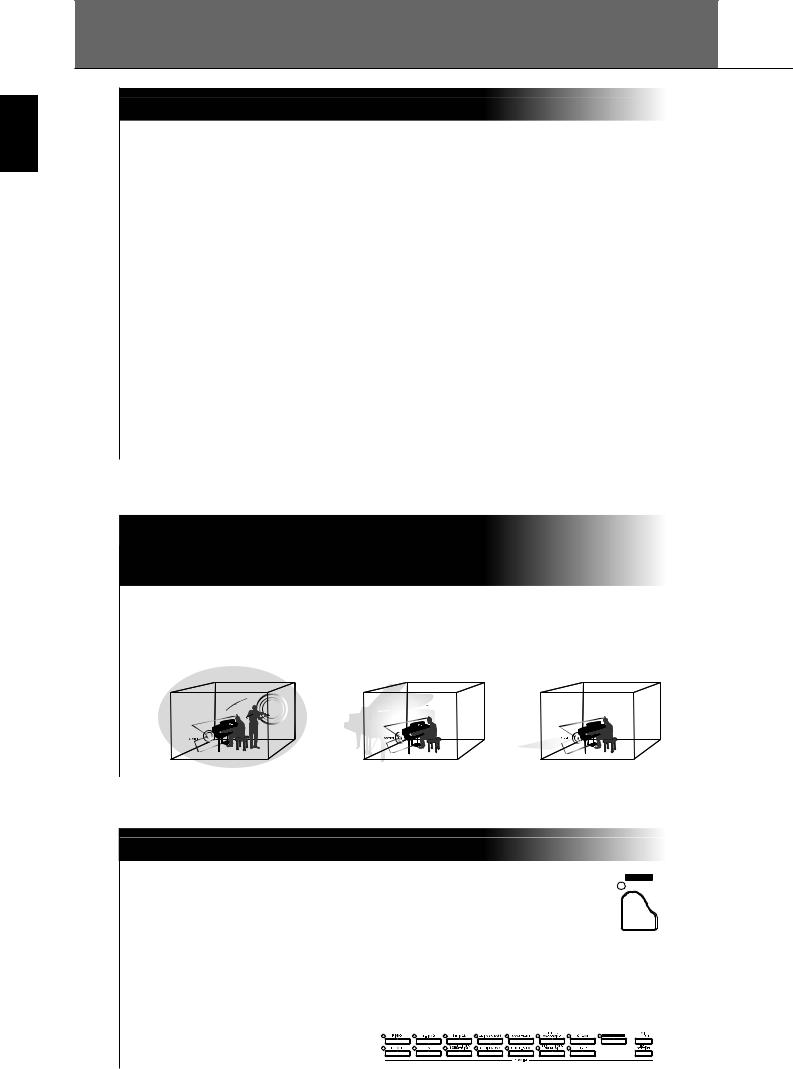
Introduction
Welcome to the Wonderful Musical World of the Clavinova CVP!
Authentic Acoustic Piano-like Touch
Natural Wood Keyboard (CVP-309 including grand piano type)
The special Natural Wood keyboard of the CVP-309 uses real wood, to reproduce as closely as possible the experience of playing an actual acoustic grand piano. The authentic touch and feel of the keys goes far beyond existing electronic keyboards, realistically recreating the hardness of the keys, the balance between the weight of the key and hammer, and the characteristic weight gradations of the keys – heavy in the low end, light in the high register – to make you feel as if you’re playing a real grand piano. Moreover, this specially crafted keyboard lets you use techniques only possible on grand pianos, such as playing the same note successively and having the sounds blend smoothly even without use of the damper pedal, or playing the same key quickly and having perfect articulation without the sound cutting off unnaturally.
GH3 Keyboard (CVP-307)
This feature provides authentic, realistic keyboard response – much like the playing feel of a grand piano – with the lower keys being heavy in touch, the higher keys light, and all the natural gradations in between. Moreover, this specially crafted keyboard lets you use techniques only possible on grand pianos, such as playing the same note successively and having the sounds blend smoothly even without use of the damper pedal, or playing the same key quickly and having perfect articulation without the sound cutting off unnaturally.
The Acoustic Ambience of a Grand Piano —with the iAFC Feature
Turn on the iAFC (Instrumental Active Field Control) effect, and hear the sound expand around you, as if you’re playing on stage in a concert hall. The overall sound is deeper and more resonant, especially when using the damper pedal, recreating and emphasizing the natural sounds of true acoustic instruments.
Playing the Clavinova
Playing Piano Voices |
page 28 |
PIANO |
|
||
With just the press of a button, you can reconfigure the entire Clavinova for |
|
|
optimum piano performance, no matter what settings you’ve made from the |
|
|
panel. Now you can enjoy performing and practicing with authentic grand |
|
|
piano sounds and response—instantly. |
|
|
Playing Other Instrument Voices .............................................. |
page 31 |
|
The Clavinova gives you not only various realistic piano Voices, but also features an exceptionally wide variety of authentic instruments, both acoustic and electronic.
ORGAN FLUTES
10 |
CVP-309/307 Owner’s Manual |
|
|
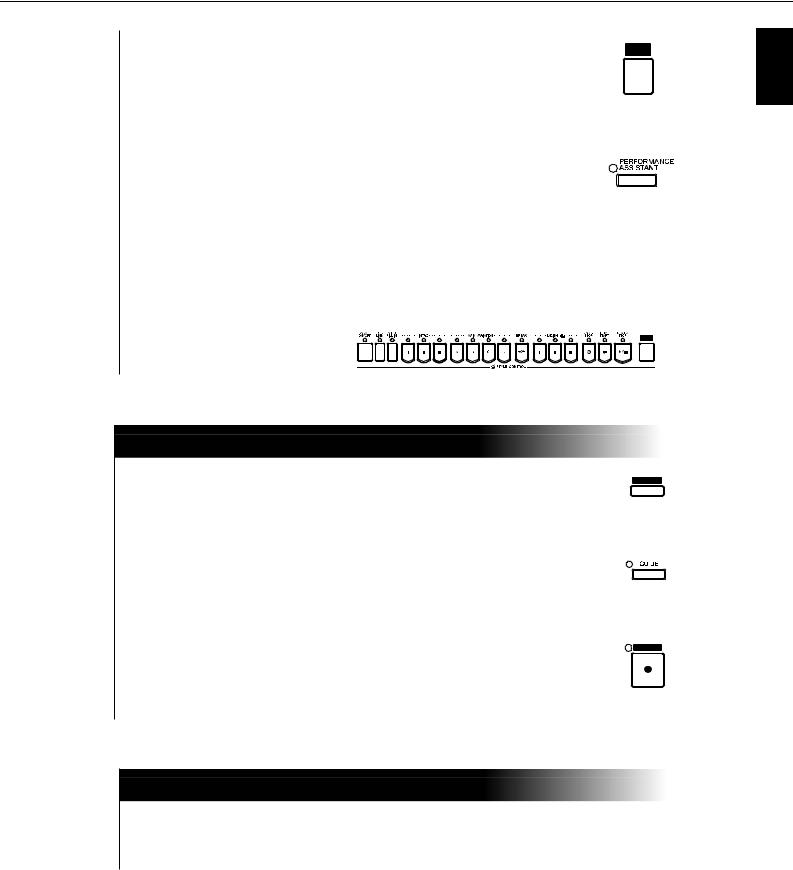
Perform Along with a Full Band |
|
SONG |
|
—Song Playback |
page 34 |
SELECT |
|
|
|
||
Play along with previously recorded Song data, and fill out your solo perfor- |
|
|
|
mance with the sounds and arrangement of an entire band or orchestra. |
|
|
|
Ease in Playing Backing Parts with Songs |
|
|
|
—performance assistant technology ........................................ |
page 42 |
|
|
The new performance assistant technology features make it exceptionally |
|
|
|
|
|
||
|
|
||
easy to play professional-sounding backing parts along with Song playback. |
|
|
|
Playing Melodies along with Auto Accompaniment |
|
|
|
—Style Playback......................................................................... |
page 44 |
|
|
Use the Style playback features to automatically produce full backing parts and accompaniment, while you play melodies on top. It’s like having an expert ensemble playing behind you. Select an accompaniment Style—such as pop, jazz, Latin, etc.— and let the Clavinova be your backing band!
STYLE
SELECT
Practicing
Displaying and Playing along with the Music Score ................ |
page 56 |
SCORE
While playing back a Song, you can have the music score (notation) automatically shown on the display—an exceptionally convenient tool for learn-
ing and practicing pieces.
Guide Lamps............................................................................... |
page 38 |
|
|
|
|
The key guide lamps are also helpful in learning and practicing, since they |
|
|
|
||
|
|
|
|||
|
|
|
|||
indicate the notes you should play, when you should play them, and how long |
|
|
|
||
|
|
|
|||
you should hold them down. |
|
|
|
|
|
Recording Your Performances .................................................. |
page 41 |
|
|
|
|
The Clavinova lets you easily record your own performances and save them |
|
|
|||
|
REC |
|
|||
to internal memory or a SmartMedia card. This, too, is an excellent practice |
|
|
|
|
|
tool, letting you listen back to your playing and spot your strong and weak |
|
|
|
|
|
points. |
|
|
|
|
|
Expand Your Song Collection
Internet Direct Connection......................................................page 170
The Clavinova also connects directly to the Internet, letting you download Song data from special websites, and save them to internal memory or a SmartMedia card.
Introduction
CVP-309/307 Owner’s Manual |
11 |
|
|
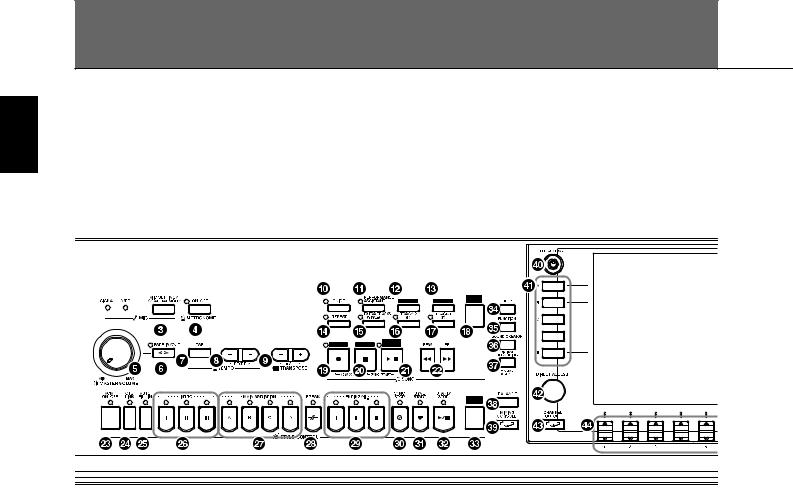
Panel Controls
Introduction
SCORE |
KARAOKE |
SONG |
SELECT |
REC |
STOP |
PLAY/ |
PAUSE |
STYLE
SELECT
1 |
[POWER] switch .............................................................. |
P. 14 |
2 SmartMedia slot ............................................................... |
P. 22 |
|
MIC. |
|
|
3 |
[MIC SETTING/VOCAL HARMONY] button .................... |
P. 54 |
METRONOME |
|
|
4 |
[ON/OFF] button ............................................................. |
P. 30 |
VOLUME |
|
|
5 |
[MASTER VOLUME] dial.................................................. |
P. 15 |
6 |
[FADE IN/OUT] button .................................................... |
P. 46 |
TEMPO |
|
|
7 |
[TAP] button .................................................................... |
P. 46 |
8 |
[–][+] buttons................................................................... |
P. 30 |
TRANSPOSE |
|
|
9 |
[–] [+] buttons.................................................................. |
P. 53 |
SONG |
|
|
0 |
[GUIDE] button ............................................................... |
P. 38 |
A [PERFORMANCE ASSISTANT] button .............................. |
P. 43 |
|
B [SCORE] button ............................................................... |
P. 37 |
|
C [KARAOKE] button .......................................................... |
P. 53 |
|
D [REPEAT] button............................................................... |
P. 40 |
|
E [EXTRA TRACKS (STYLE)] button.................................... |
P. 138 |
|
F [TRACK 2 (L)] button........................................................ |
P. 40 |
|
G [TRACK 1 (R)] button ....................................................... |
P. 38 |
|
H [SONG SELECT] button.................................................... |
P. 34 |
|
I [REC] button .................................................................... |
P. 41 |
|
J [STOP] button.................................................................. |
P. 35 |
|
K [PLAY/PAUSE] button....................................................... |
P. 35 |
|
L [REW]/[FF] buttons......................................................... |
P. 132 |
|
STYLE CONTROL |
|
M [ACMP ON/OFF] button................................................... |
P. 45 |
N [OTS LINK] button ........................................................... |
P. 50 |
O [AUTO FILL IN] button..................................................... |
P. 47 |
P INTRO [I]/[II]/[III] buttons................................................. |
P. 46 |
Q MAIN VARIATION [A]/[B]/[C]/[D] buttons........................ |
P. 47 |
R [BREAK] button ................................................................ |
P. 47 |
S ENDING/rit. [I]/[II]/[III] buttons ........................................ |
P. 47 |
T [SYNC STOP] button ........................................................ |
P. 47 |
U [SYNC START] button....................................................... |
P. 46 |
V [START/STOP] button ....................................................... |
P. 46 |
W [STYLE SELECT] button..................................................... |
P. 45 |
X [HELP] button .................................................................. |
P. 57 |
Y [FUNCTION] button ........................................................ |
P. 26 |
Z [SOUND CREATOR] button ............................................. |
P. 93 |
[ [DIGITAL RECORDING] button ............................. |
P. 117, 141 |
\ [BALANCE] button ........................................................... |
P. 39 |
] [MIXING CONSOLE] button ............................................ |
P. 82 |
^ [LCD CONTRAST] knob .................................................. |
P. 18 |
a [A]–[J] buttons.................................................................. |
P. 25 |
b [DIRECT ACCESS] button ................................................. |
P. 58 |
c [CHANNEL ON/OFF] button.................................. |
P. 103, 137 |
d [1π†]–[8π†] buttons................................................. |
P. 25 |
e TAB [√][®] buttons ......................................................... |
P. 26 |
f [EXIT] button.................................................................... |
P. 26 |
g [DEMO] button ................................................................ |
P. 23 |
h [MUSIC FINDER] button .................................................. |
P. 50 |
i [DATA ENTRY] dial .......................................................... |
P. 61 |
j [ENTER] button ................................................................ |
P. 61 |
12 |
CVP-309/307 Owner’s Manual |
|
|
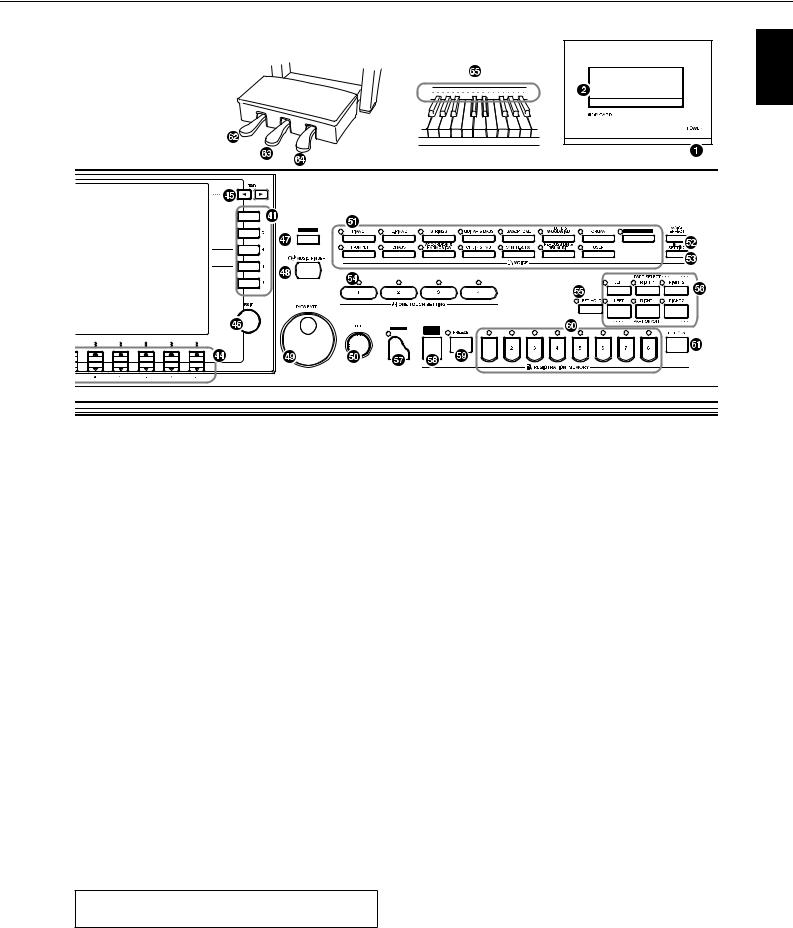
Introduction
DEMO |
ORGAN FLUTES |
PIANO |
REGIST. |
|
BANK |
VOICE |
|
k VOICE buttons ................................................................. |
P. 31 |
l [VOICE EFFECT] button ................................................... |
P. 80 |
m [iAFC SETTING] button.................................................... |
P. 76 |
ONE TOUCH SETTING |
|
n [1]–[4] buttons ................................................................. |
P. 49 |
o [LEFT HOLD] button........................................................ |
P. 48 |
PART |
|
p PART buttons ................................................................... |
P. 73 |
PIANO Setting |
|
q [PIANO] button ............................................................... |
P. 28 |
REGISTRATION MEMORY |
|
r [REGIST. BANK] button.................................................. |
P. 126 |
s [FREEZE] button ............................................................. |
P. 127 |
t [1]–[8] buttons ............................................................... |
P. 125 |
u [MEMORY] button ......................................................... |
P. 125 |
Pedals |
|
v Left pedal......................................................................... |
P. 29 |
w Sostenuto pedal ............................................................... |
P. 29 |
x Damper pedal.................................................................. |
P. 29 |
y Keyboard guide lamps ..................................................... |
P. 38 |
For information on the jacks and connectors located on the bottom left of the instrument, see page 184.
CVP-309/307 Owner’s Manual |
13 |
|
|
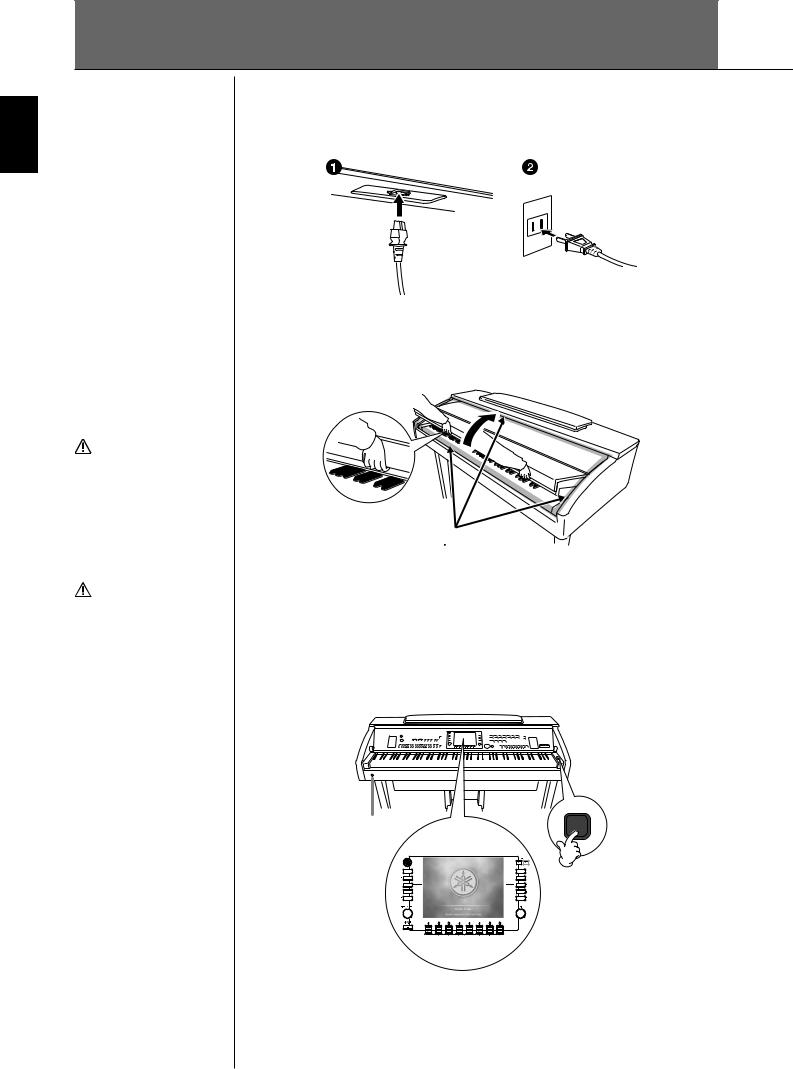
Playing the Keyboard
Introduction
 CAUTION
CAUTION
the cover with both hands when opening or closing it. Do not release it until it is fully opened or closed. Be careful to avoid catching fingers (yours or others, especially children’s) between the cover and the unit.
 CAUTION
CAUTION
not place objects such as a piece of metal or paper on top of the key cover. Small objects placed on the key cover may fall inside the unit when the cover is opened and may be nearly impossible to remove. This could cause electric shock, short circuit, fire or other serious damage to the instrument.
1
2
3
Connecting the power cable
First insert the plug of the power cable into the AC connector on the Clavinova, then plug the other end of the cable into the proper AC outlet on the wall.
(The shape of the plug and outlet differ depending on locale.)
Opening the key cover
Using the hand grip on the front, lift open the key cover.
 CAUTION
CAUTION
Be careful to avoid catching your fingers when opening the cover.
Turning the power on
Press the [POWER] switch located on the right of the keyboard to turn the power on. The display located in the center of the front panel and the power indicator located below the left end of the keyboard lights up.
The power indicator lights up.
14 |
CVP-309/307 Owner’s Manual |
|
|
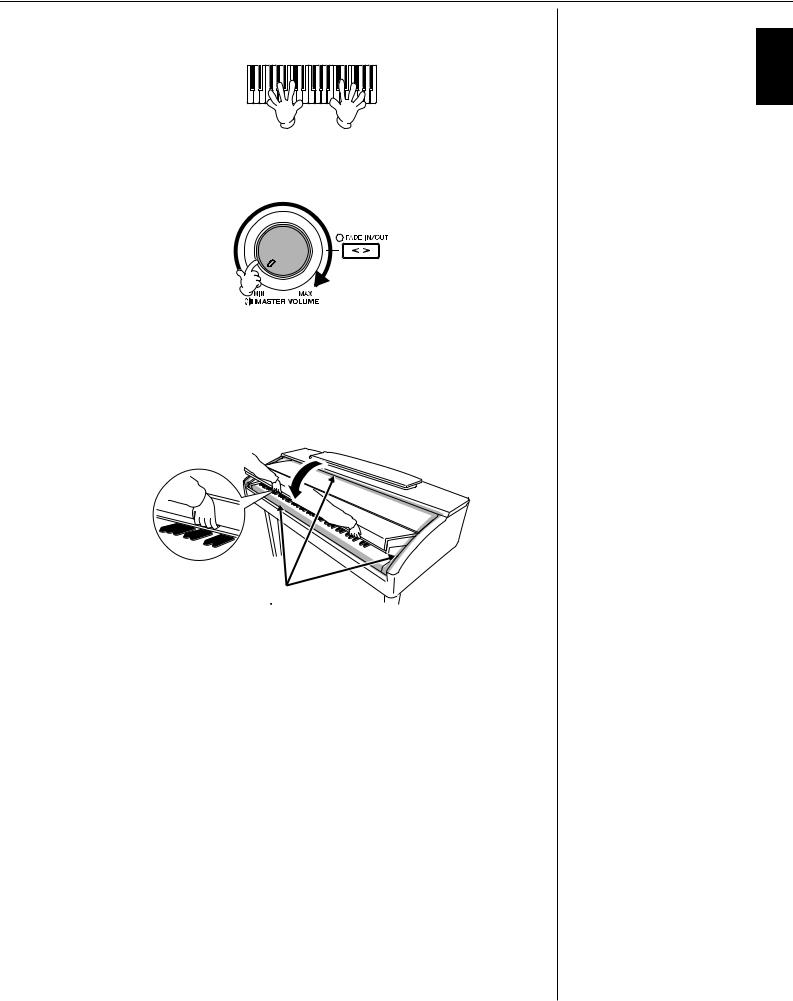
4 Playing the keyboard
Play the keyboard to produce sound.
Adjusting the volume
While playing the keyboard, adjust the volume level by using the [MASTER VOLUME] located at the left of the panel.
5 Turning the power off
Press the [POWER] switch to turn the power off. The screen and the power indicator turn off.
6 Closing the key cover
Grip the metal rim at the top of the panel, and close the key cover.
 CAUTION
CAUTION
Be careful to avoid catching your fingers when closing the cover.
Introduction
CVP-309/307 Owner’s Manual |
15 |
|
|
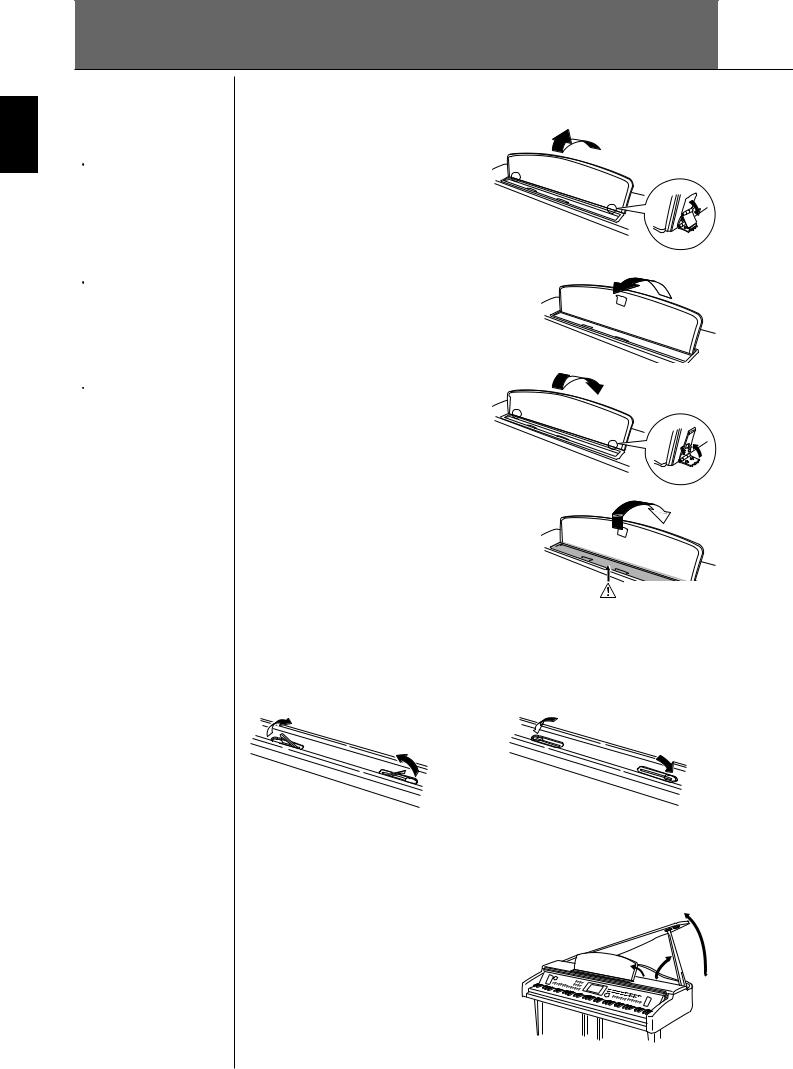
Introduction
Setting Up the Clavinova
 CAUTION
CAUTION
Do not try to use the music rest in a half-raised position. Also, when lowering the music rest, let the music rest all the way down before releasing it.
 CAUTION
CAUTION
When raising or lowering the music rest, do not release your hands from the music rest until it is all the way up or down.
 CAUTION
CAUTION
Before lowering the music rest, close the sheet music braces (see below).
The music rest will not close unless the sheet music braces are also closed.
To turn on the iAFC (page 76), open the lid with the longer stay using the inner recess. When the lid is closed or open with the shorter stay, the iAFC will not be turned on.
Music Rest
To Raise the Music Rest:
CVP-309 grand piano type
1Pull the music rest up and toward yourself as far as it will go.
2Flip down the two metal supports at the left and the right on the rear of the music rest.
3Lower the music rest so that it rests on the metal supports.
CVP-309/307
Pull the music rest toward yourself as far as it will go. When raised, the music rest is fixed at a certain angle and cannot be adjusted.
CVP-309 grand piano type
CVP-309/307
To Lower the Music Rest:
CVP-309 grand piano type
1Pull the music rest toward yourself as far as it will go.
2Raise the two metal supports until they are flat against the rear surface of the music rest.
CVP-309 grand piano type
3Gently lower the music rest backward until it is all the way down.
CVP-309/307
Lift the music rest slightly, then turn it back slowly.
CVP-309/307
Close the sheet
music braces
CAUTION
Be careful to avoid catching your fingers.
Sheet Music Braces
These braces are for holding the pages of music books in place.
To Open |
|
To Close |
|
|
|
|
|
|
|
|
|
|
|
|
|
Lid (CVP-309 grand piano type)
One long stay and one short stay are provided on the lid. Use one of them to open the lid to the desired angle.
■ To open the lid: |
2 |
|
|
|
|
1 |
Raise the music rest as described in “Music |
|
|
Rest” above. |
3 |
2 |
Raise and hold the right side of the lid (viewed |
1 |
|
||
from the keyboard end of the instrument).
3 Raise the lid stay and carefully lower the lid so that the end of the stay fits into the recess in the lid.
16 |
CVP-309/307 Owner’s Manual |
|
|
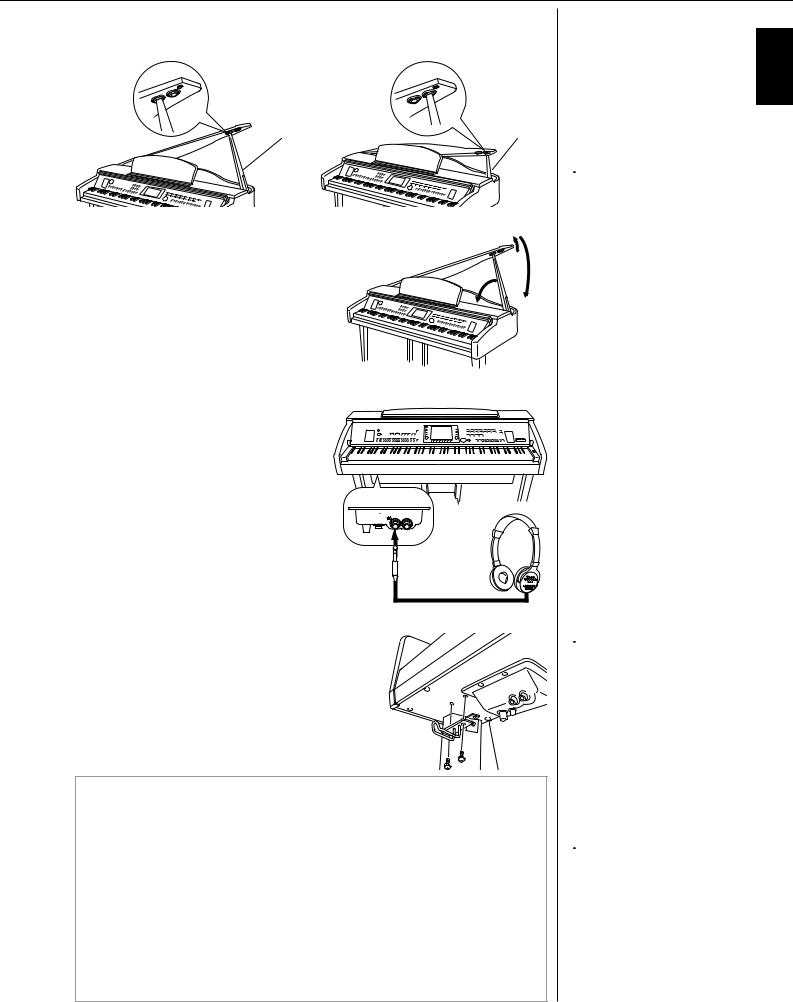
Using Headphones
For the longer stay, use the inner recess, and for the shorter stay, use the outer recess to support the lid.
Longer stay |
Shorter stay |
■ To close the lid: |
1 |
|
1 |
Hold the lid stay and carefully raise the lid. |
|
2 |
Hold the lid in its raised position and |
3 |
|
lower the lid stay. |
2 |
3 |
Carefully lower the lid. |
|
Using Headphones
Connect a pair of headphones to one of the [PHONES] jacks located on the bottom left of the instrument.
Two sets of standard stereo headphones can be connected. (If you are using only one pair of headphones, you can plug them into either of these jacks.)
INPUT |
MIC. |
MIC. LINE PHONES |
VOLUME |
LINE IN |
|
MIN MAX |
|
|
Using the Headphone Hanger
A headphone hanger is included in the Clavinova package so that you can hang the headphones on the Clavinova. Install the headphone hanger using included two screws (4 x 10mm) as shown in the figure.
Outputting sound from the speaker while headphones are connected
1Call up the operation display.
[FUNCTION]→ [I] UTILITY → TAB[√][®] CONFIG 2
2Press the [5†]/[6†] (SPEAKER) button to select “ON.”
Outputting sound only from the headphones
From the display called up in step 1 above, press the [5†]/[6†] (SPEAKER) button to select “OFF.”
When “OFF” is selected, the speakers will not sound and you can only hear the Clavinova sound via the headphones.
 CAUTION
CAUTION
•Make sure that the end of the stay fits securely in the lid recess. If the stay is not properly seated in the recess, the lid may fall, causing damage or injury.
•Be careful that you or others do not bump the stay while the lid is raised. The stay may be bumped out of the lid recess causing the lid to fall.
•Be careful to avoid catching fingers (yours or others, especially children’s) when raising or lowering the lid.
 CAUTION
CAUTION
Do not listen with the headphones at high volume for long periods of time. Doing so may cause hearing loss.
 CAUTION
CAUTION
Do not hang anything other than the headphones on the hanger. Otherwise, the Clavinova or the hanger may be damaged.
Introduction
CVP-309/307 Owner’s Manual |
17 |
|
|
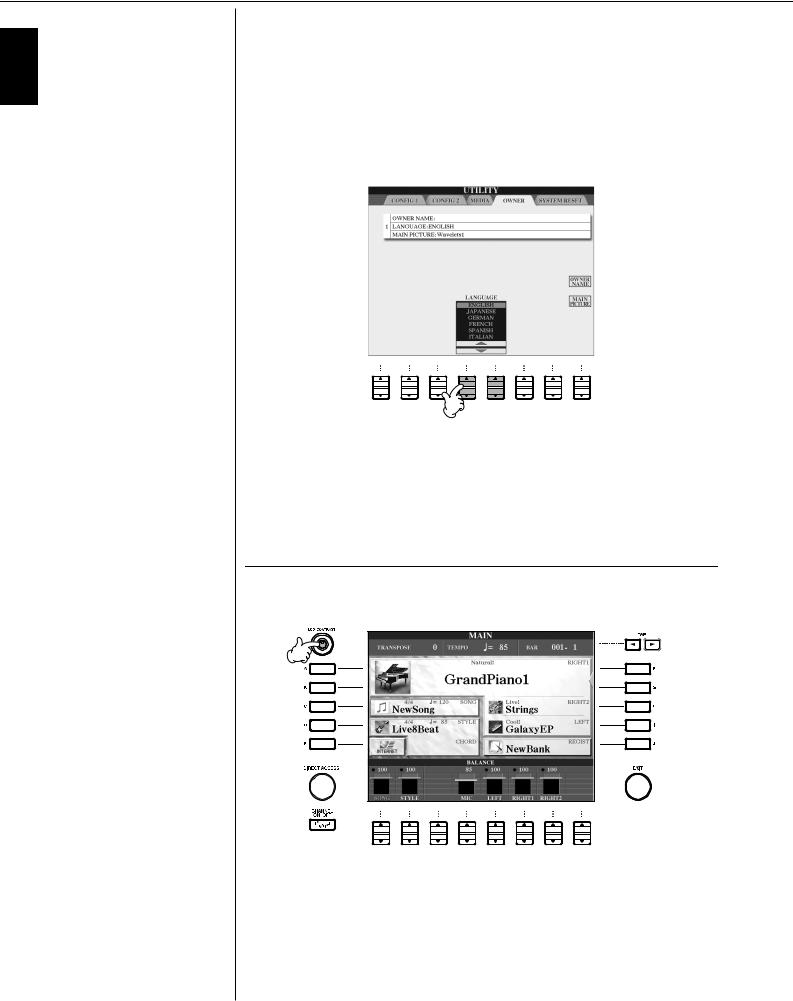
Introduction
Changing the Display Language
Changing the Display Language
This determines the language used in the display for messages, file names, and character input.
1 Call up the operation display.
[FUNCTION] → [I] UTILITY → TAB[√][®] OWNER
2 Press the [4π†]/[5π†] button to select a language.
1 |
2 |
3 |
4 |
5 |
6 |
7 |
8 |
Display Settings
Adjusting the Contrast of the Display
You can adjust the contrast of the display by turning the [LCD CONTRAST] knob located to the left of the display.
1 |
2 |
3 |
4 |
5 |
6 |
7 |
8 |
18 |
CVP-309/307 Owner’s Manual |
|
|
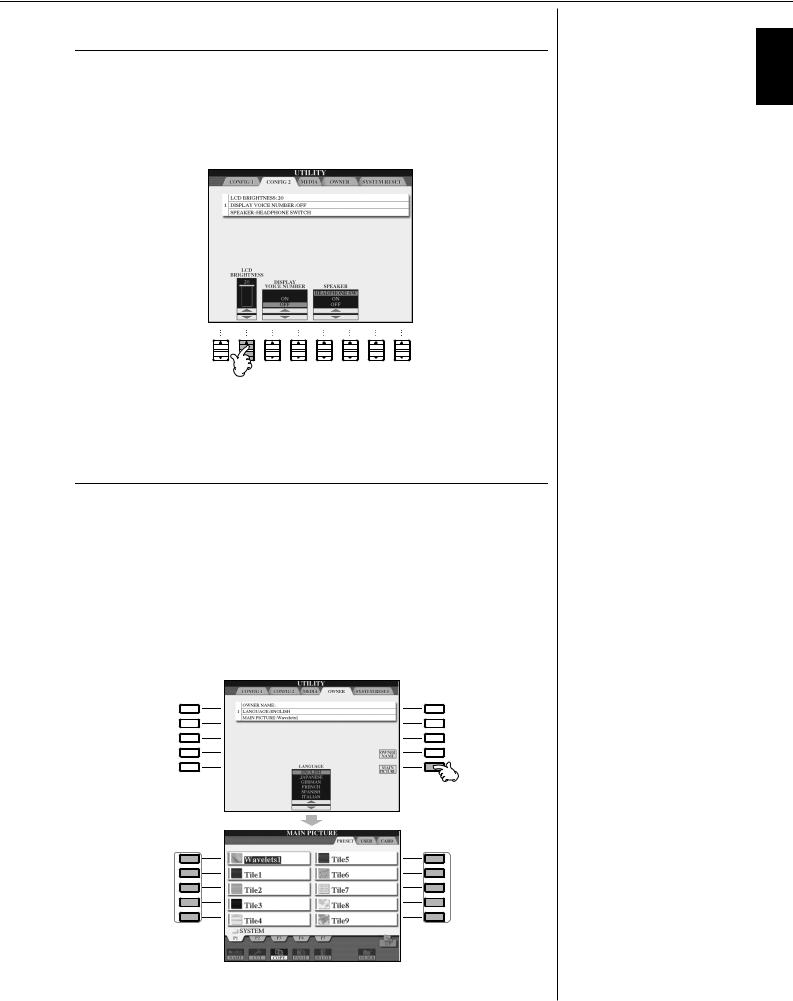
Adjusting the Brightness of the Display
Adjust the brightness of the display.
1 Call up the operation display.
[FUNCTION] → [I] UTILITY → TAB[√][®] CONFIG 2
2 Press the [2π†] button to adjust the brightness of the display.
1 |
2 |
3 |
4 |
5 |
6 |
7 |
8 |
Selecting a Picture for the Main Display Background
This function lets you select your favorite picture to be used as background for the Main display (page 25).
1 Call up the operation display.
[FUNCTION] → [I] UTILITY → TAB[√][®] OWNER
2 Press the [J] (MAIN PICTURE) button to call up the Picture Selection
Display.
3 Use the [A]–[J] buttons to select a picture.
A |
F |
B |
G |
C |
H |
D |
I |
E |
J |
2
A |
F |
B |
G |
3 C |
H 3 |
D |
I |
E |
J |
Display Settings
Introduction
CVP-309/307 Owner’s Manual |
19 |
|
|

Introduction
Display Settings
The explanation about picture compatibility at right applies also to the background of the Song Lyrics display.
After selecting, press the [DIRECT ACCESS] button then press the [EXIT] button to return to the Main display. The newly selected picture is shown as the background of the Main display.
Importing a favorite picture for the Main display background
Even though a variety of pictures are available on the Preset drive, you can load your own favorite picture data from SmartMedia card to the Clavinova for use as background.
Make sure to use images no larger than 640 x 480 pixels.
If you select a picture file on the SmartMedia card, etc, the background may take some time to appear. If you want to reduce this time, save the background from the CARD/USB drive to the USER drive of the Picture Selection display.
If you select a picture file on the CARD/USB drive, the selected background will not be displayed when the power is turned on again unless the same media containing the data has been inserted into the drive.
Entering the Owner Name in the Opening Display
You can have your name appear in the opening display (the display that first appears when the power is turned on).
1 Call up the operation display.
[FUNCTION] → [I] UTILITY → TAB[√][®] OWNER
2 Press the [I] (OWNER NAME) button and call up the Owner Name display.
Refer to page 67 for character-entry details.
Displaying the version number
To check the version number of this instrument, press and hold the [I] (OWNER NAME) button in the display in step 2 above.
20 |
CVP-309/307 Owner’s Manual |
|
|

Handling the Floppy Disk Drive (FDD) and Floppy Disks
(The floppy disk drive may be included or optional, depending on your locale. For instructions on installing the floppy disk drive, see page 212.)
The floppy disk drive lets you save original data you’ve created on the instrument to floppy disk, and allows you to load data from floppy disk to the instrument.
Be sure to handle floppy disks and treat the disk drive with care. Follow the important precautions below.
Floppy Disk Compatibility
• 3.5" 2DD and 2HD type floppy disks can be used.
Formatting a Floppy Disk
•If you find that you are unable to use new, blank disks or old disks that have been used with other devices, you may need to format them. For details on how to format a disk, see page 62. Keep in mind that all data on the disk will be lost after formatting. Make sure to check beforehand whether or not the disk contains important data.
n
Floppy disks formatted on this device may or may not be useable as is on other devices.
Inserting/Removing Floppy Disks
Inserting a Floppy Disk into the Disk Drive:
•Hold the disk so that the label of the disk is facing upward and the sliding shutter is facing forward, towards the disk slot. Carefully insert the disk into the slot, slowly pushing it all the way in until it clicks into place and the eject button pops out.
n
Never insert anything but floppy disks into the disk drive. Other objects may cause damage to the disk drive or floppy disks.
Removing a Floppy Disk
•After checking that the instrument is not accessing* the floppy disk (checking that the use lamp on the floppy disk drive is off), firmly press the eject button at the upper right of the disk slot all the way in.
When the floppy disk is ejected, pull it out of the drive. If the floppy disk cannot be removed because it is stuck, do not try to force it, but instead try pressing the eject button again, or try re-inserting the disk and attempt to eject it again.
*Access of the disk indicates an active operation, such as recording, playback, or deletion of data.
If a floppy disk is inserted while the power is on, the disk is automatically accessed, since the instrument checks whether the disk has data.
 CAUTION
CAUTION
Do not remove the floppy disk or turn off the instrument itself while the disk is being accessed.
Doing so may result not only in loss of data on the disk but also damage to the floppy disk drive.
•Be sure to remove the floppy disk from the disk drive before turning off the power. A floppy disk left in the drive for extended periods can easily pick up dust and dirt that can cause data-read and -write errors.
Cleaning the Disk Drive Read/Write Head
•Clean the read/write head regularly. This instrument employs a precision magnetic read/write head which, after an extended period of use, will pick up a layer of magnetic particles from the disks used that will eventually cause read and write errors.
•To maintain the disk drive in optimum working order Yamaha recommends that you use a commercially-avail- able dry-type head cleaning disk to clean the head about once a month. Ask your Yamaha dealer about the availability of proper headcleaning disks.
About Floppy Disks
Handle floppy disks with care, and follow these precautions:
•Do not place heavy objects on a disk or bend or apply pressure to the disk in any way. Always keep floppy disks in their protective cases when they are not in use.
•Do not expose the disk to direct sunlight, extremely high or low temperatures, or excessive humidity, dust or liquids.
•Do not open the sliding shutter and touch the exposed surface of the floppy disk inside.
•Do not expose the disk to magnetic fields, such as those produced by televisions, speakers, motors, etc., since magnetic fields can partially or completely erase data on the disk, rendering it unreadable.
•Never use a floppy disk with a deformed shutter or housing.
•Do not attach anything other than the provided labels to a floppy disk. Also make sure that labels are attached in the proper location.
To Protect Your Data (Write-protect Tab):
•To prevent accidental erasure of important data, slide the disk's write-protect tab to the “protect” position (tab open). When saving data, make sure that the disk's write-protect tab is set to the “overwrite” position (tab closed).
Write-protect tab open (protect position)
Introduction
CVP-309/307 Owner’s Manual |
21 |
|
|

Introduction
Handling SmartMediaTM*Memory Cards
*SmartMedia is a trademark of Toshiba Corporation.
This instrument features a built-in SmartMedia card slot (on the front panel). It lets you save original data you’ve created on the instrument to a SmartMedia card, and allows you to load data from a card to the instrument. Be sure to handle SmartMedia cards with care. Follow the important precautions below.
Compatible SmartMedia Types
•3.3V (3V) SmartMedia can be used. 5V type SmartMedia is not compatible with this instrument.
•SmartMedia cards of seven different memory capacities of (2MB, 4MB, 8MB, 16MB, 32MB, 64MB, and 128MB) can be used with the instrument. SmartMedia cards greater than 32MB can be used if they conform to the SSFDC Forum standard.
n
SSFDC is an abbreviation for Solid State Floppy Disk Card (another name for SmartMedia cards). The SSFDC Forum is a voluntary organization established for the promotion of SmartMedia.
Formatting SmartMedia Cards
If you find that you are unable to use new, blank SmartMedia cards or cards that have been used with other devices, you may need to format them. For details on how to format a SmartMedia card, see page 62. Keep in mind that all data on the card will be lost after formatting. Make sure to check beforehand whether or not the card contains important data.
n
SmartMedia cards formatted on this device may or may not be useable as is on other devices.
Inserting/Removing SmartMedia Cards
Inserting SmartMedia Cards
•Insert the SmartMedia card with the terminal (goldplated) side face down into the card slot, until it clicks into place.
•Do not insert the SmartMedia card in the wrong direction.
•Do not insert anything other than a SmartMedia card in the slot.
Removing SmartMedia Cards
•After making sure that the instrument is not accessing* the SmartMedia card, insert the card until it clicks into place and release it. When the SmartMedia card is ejected, pull it out of the drive. If the card cannot be removed because it is stuck, do not try to force it, but instead try re-inserting the card completely into the slot and attempt to eject it again.
*Accessing includes saving, loading, formatting, deleting and making directory. Also, be aware that the instrument will automatically access the SmartMedia to check the media type when it is inserted while the instrument is turned on.
 CAUTION
CAUTION
Never attempt to remove the SmartMedia card or turn the power off during accessing. Doing so can damage the data on the instrument or card and possibly damage the SmartMedia card itself.
About SmartMedia Cards
Handle SmartMedia cards with care, and follow these precautions:
•There are times when static electricity affects SmartMedia. Before you touch a SmartMedia card, touch something metallic such as a door knob and aluminum sash, to reduce the possibility of static electricity.
•Be sure to remove the SmartMedia card from the SmartMedia slot when it is not in use for a long time.
•Do not expose the SmartMedia to direct sunlight, extremely high or low temperatures, or excessive humidity, dust or liquids.
•Do not place heavy objects on a SmartMedia card or bend or apply pressure to the card in any way.
•Do not touch the gold-plated terminals of the SmartMedia card or put any metallic plate onto the terminals.
•Do not expose the SmartMedia card to magnetic fields, such as those produced by televisions, speakers, motors, etc., since magnetic fields can partially or completely erase data on the SmartMedia, rendering it unreadable.
•Do not attach anything other than the provided labels to a SmartMedia. Also make sure that labels are attached in the proper location.
To Protect Your Data (Write-protect):
•To prevent inadvertent erasure of important data, affix the write-protect seal (provided in the SmartMedia package) onto the designated area (within the circle) of the SmartMedia card. Conversely, to save data on the SmartMedia card, make sure to remove the write-protect seal from the card.
•Do not reuse a seal that has been peeled off.
22 |
CVP-309/307 Owner’s Manual |
|
|

Quick Guide
Playing the Demos
The Demos are more than just songs—they also provide helpful, easy-to-understand introductions to the features, functions and operations of the instrument. In a way, the Demos are an interactive “mini-man- ual”—complete with sound demonstrations and text showing what it can do for you.
DEMO
1 Select the desired Language.
1 Press the [HELP] button to call up |
|
the language selection display. |
1 |
|
2Press the [6π†]/[7π†] buttons to select the desired language.
1 |
2 |
3 |
4 |
5 |
6 |
7 |
8 |
2
3
Press the [DEMO] button to start the Demos.
Demos will play back continuously until stopped.
Press the [EXIT] button to stop the Demo playback.
When the Demo stops, the display returns to the MAIN display.
2 
DEMO
Guide Quick
CVP-309/307 Owner’s Manual |
23 |
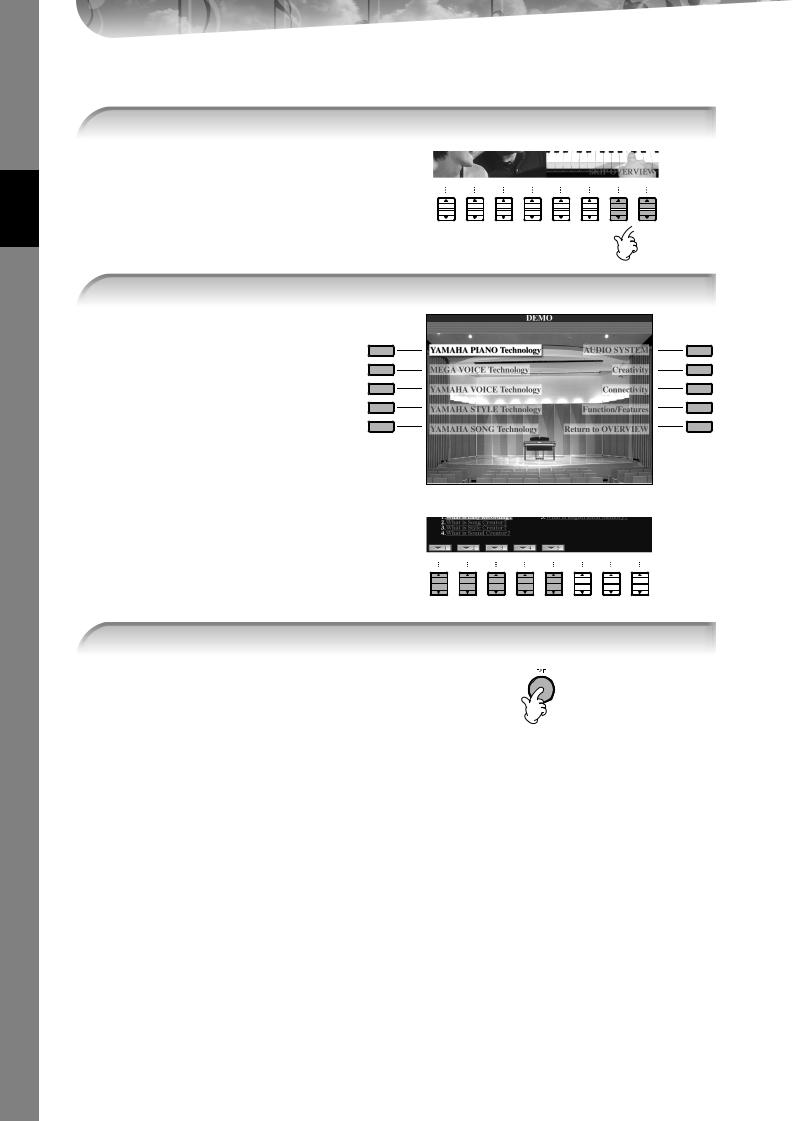
Quick Guide
Showing Specific Demo Topics
1 Press the [7π†]/[8π†] buttons in the Demo display to call up the specific Demo menu.
1 2 3 4 5 6 7  8
8
2 Press one of the [A]–[I] buttons to show a specific Demo.
To return back to the previous display, |
|
press the [J] button. |
|
A |
F |
B |
G |
C |
H |
D |
I |
E |
J |
When the Demo has more than one screen.
Press a [π†] button corresponding to the screen number.
1 |
2 |
3 |
4 |
5 |
6 |
7 |
8 |
3 Press the [EXIT] button to exit from Demo.
24 |
CVP-309/307 Owner’s Manual |

Operations in the Basic Displays
To start with, you should know a little about the basic displays that appear in the Quick Guide. There are three basic displays:
Main display |
See below. |
File selection display |
See below. |
Function display |
page 26 |
Operation of the Main Display
The Main display shows the basic settings and important information for the instrument (It is the same display that appears when the instrument is turned on.).You can also call up display pages related to the displayed function from the Main display.
nAbout information in the Main display
See page 59.
1[A]–[J] buttons
The [A]–[J] buttons correspond to the settings indicated next to the buttons.
For example, press the [F] button, and the Voice (RIGHT 1) selection display will appear in the display.
2[1π†]–[8π†] buttons
The [1π†]–[8π†] buttons correspond to the parameters which are indicated above the buttons.
For example, pressing the [1π] button will increase the Song (page 34) volume.
3[DIRECT ACCESS] and [EXIT] buttons
Here’s a convenient way to return to the Main display from any other display: Simply press the [DIRECT ACCESS] button, then the [EXIT] button.
1 |
1 |
A |
F |
B |
G |
C |
H |
D |
I |
E |
J |
3 |
|
|
|
|
|
|
3 |
2 |
|
|
|
|
|
|
|
1 |
2 |
3 |
4 |
5 |
6 |
7 |
8 |
Operation of the File Selection Display
In the File Selection display, you can select the Voice (page 28)/Song (page 34)/Style (page 44), etc. In the example here, we’ll call up and use the Song Selection display.
|
|
|
|
|
|
|
|
2 |
|
A |
|
|
|
|
|
|
F |
|
B |
|
|
|
|
|
|
G |
SONG |
|
|
|
|
|
|
|
|
SELECT |
|
|
|
|
|
|
|
|
|
C |
|
|
|
|
|
|
H |
1 |
D |
|
|
|
|
|
|
I |
E |
|
|
|
|
|
|
J |
|
|
3, 5 |
|
|
|
|
|
|
3, 5 |
|
4 |
|
|
|
|
|
|
|
|
1 |
2 |
3 |
4 |
5 |
6 |
7 |
8 |
Guide Quick
CVP-309/307 Owner’s Manual |
25 |
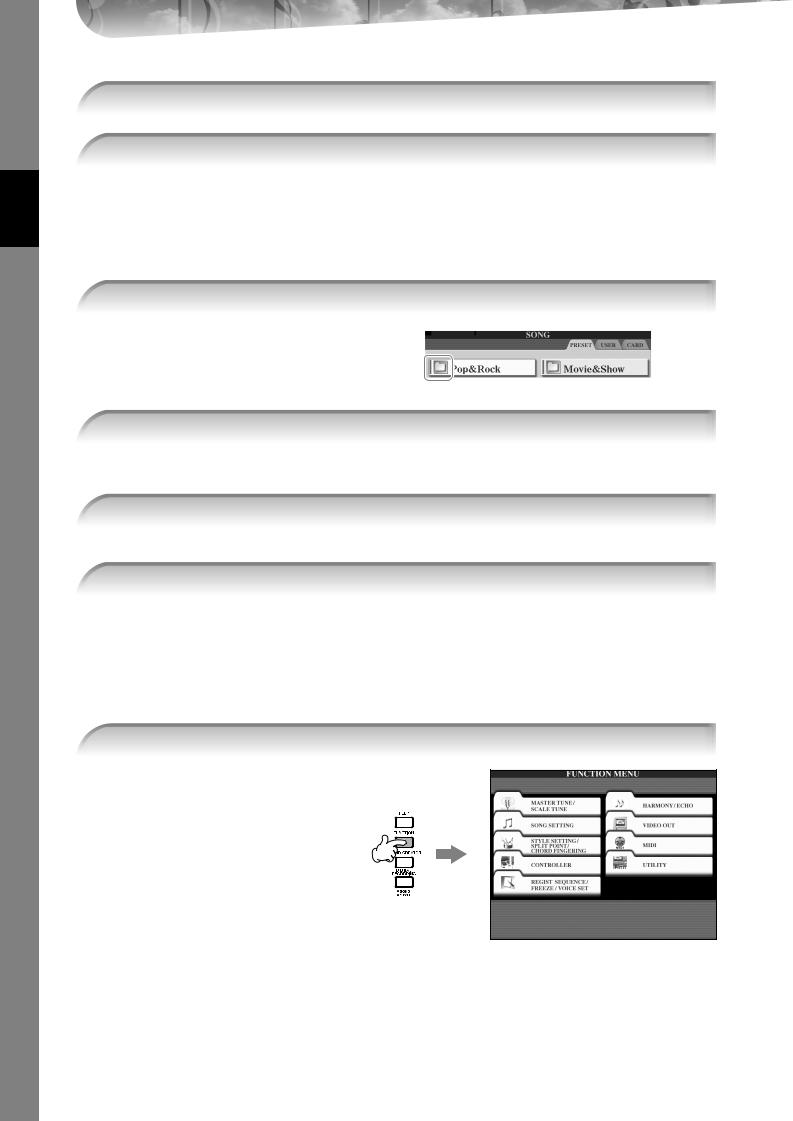
Quick Guide
1 Press the [SONG SELECT] button to call up the Song Selection display.
2 Press the TAB [√]/[®] buttons to select the desired drive (PRESET/USER/CARD).
About PRESET/USER/CARD
PRESET .............. |
Internal memory to which the preprogrammed data are installed as preset data. |
USER ................. |
Internal memory that allows both reading and writing of data. |
CARD ................ |
For transferring data to and from SmartMedia, with the CVP’s card slot. |
nWhen the USB storage device such as the Floppy Disk drive will be connected to the USB [TO DEVICE] connector, “USB” will be displayed on the File Selection display (See page 190, “Using USB Storage Devices,” Step 2.).
3 Select a folder (if necessary).
Several Songs may be together in a folder. In this case, the folder(s) will appear in the display (see the illustration at right). Press one of the [A]–[J] buttons to select a folder.
4 Select a page (if the display has several pages).
When the drive contains more than ten Songs, the display is divided up into several pages. The page indications are shown at the bottom of the display. Press one of the [1π]–[6π] buttons to select a page.
5 Press one of the [A]–[J] buttons to select a Song.
You can also select a Song by using the [DATA ENTRY] dial, then press the [ENTER] button to execute.
6 Press the [EXIT] button to return to the previous display.
Operation of the Function Display
In the Function display, you can make detailed settings.
In the example here, we’ll call up and use the keyboard touch sensitivity setting display.
1 Press the [FUNCTION] button.
Categories of detailed settings are shown.
26 |
CVP-309/307 Owner’s Manual |

2 Press the [D] button to select the category CONTROLLER.
When the selected category is further divided into sub-categories, the tab(s)
will be shown in the display.
A
B
C
D
E
3 Press the TAB [®] button to select the KEYBOARD/PANEL tab.
When the setting is further divided into additional settings, a list will be shown in the display.
4 Press the [A] button to select the “1 INITIAL TOUCH.”
4
A
B
C
D
E
5
1 |
2 |
3 |
4 |
5 |
6 |
7 |
8 |
5 Press the [1π†]/[2π†] button to select touch sensitivity for the keyboard.
Throughout this manual, arrows are used in the instructions, indicating in shorthand the process of calling up certain displays and functions.
For example, the instructions above can be indicated in shorthand as: [FUNCTION] → [D] CONTROLLER → TAB [®] KEYBOARD/PANEL → [A] 1 INITIAL TOUCH.
Guide Quick
CVP-309/307 Owner’s Manual |
27 |
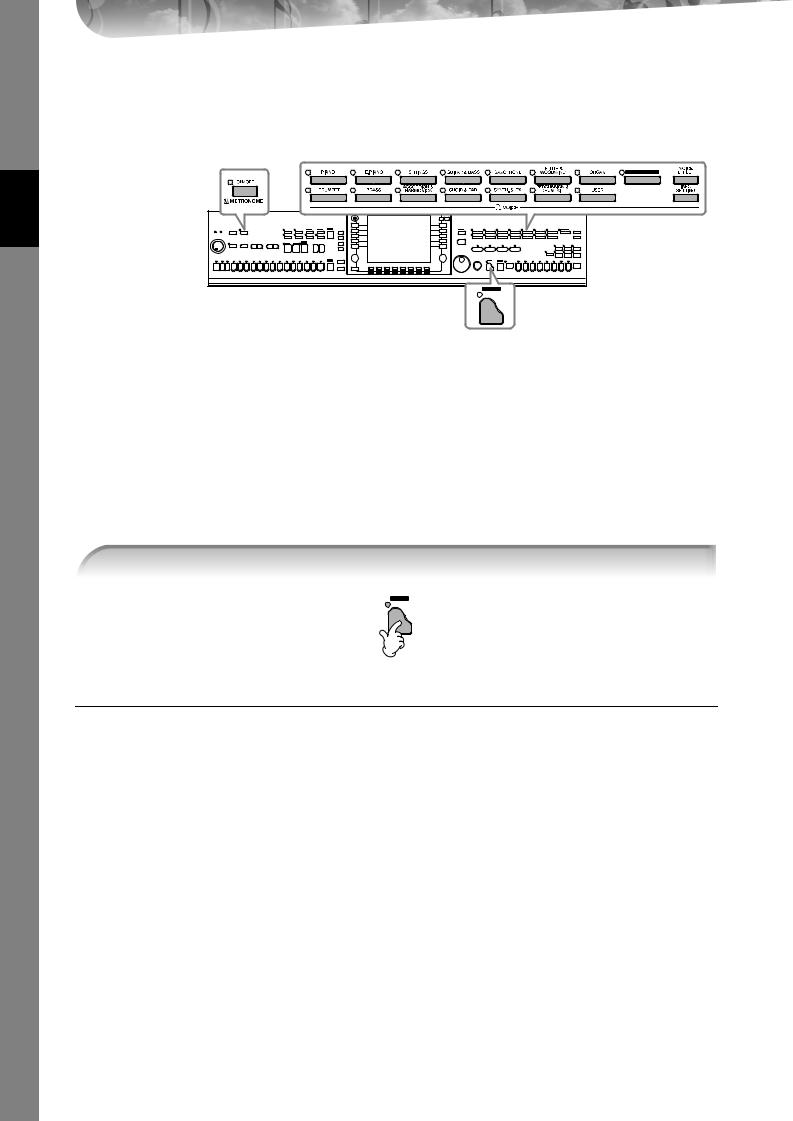
Quick Guide
Playing Voices
The Clavinova features a variety of Voices, including exceptionally realistic piano Voices.
VOICE buttons (page 31)
METRONOME |
ORGAN FLUTES |
[ON/OFF] button (page 30)
PIANO
[PIANO] button (see below)
Playing the Piano Voice
Here, we’ll call up and play the piano voice. You can play the piano voice using the pedals or metronome.
One-touch Piano Play
This convenient, easy-to-use feature completely and automatically reconfigures the entire CVP for optimum piano performance. No matter what settings you’ve made from the panel, you can instantly call up the piano settings by a single button press.
Press the piano-shaped [PIANO] button on the lower right of the panel.
PIANO
Piano Lock Function
The convenient Piano Lock function lets you “lock” the piano so that you don’t inadvertently change the settings by pressing another button on the panel. Once locked, the CVP stays in the piano mode, even if other buttons are pressed—preventing you from accidentally starting a Song (page 34) during your piano performance.
1Hold down the [PIANO] button on the lower right of the panel for a short time, until a message appears prompting you to enable Piano Lock.
2Press the [F] (OK) button to enable Piano Lock.
3To turn Piano Lock off, hold down the [PIANO] button again for a short time.
28 |
CVP-309/307 Owner’s Manual |
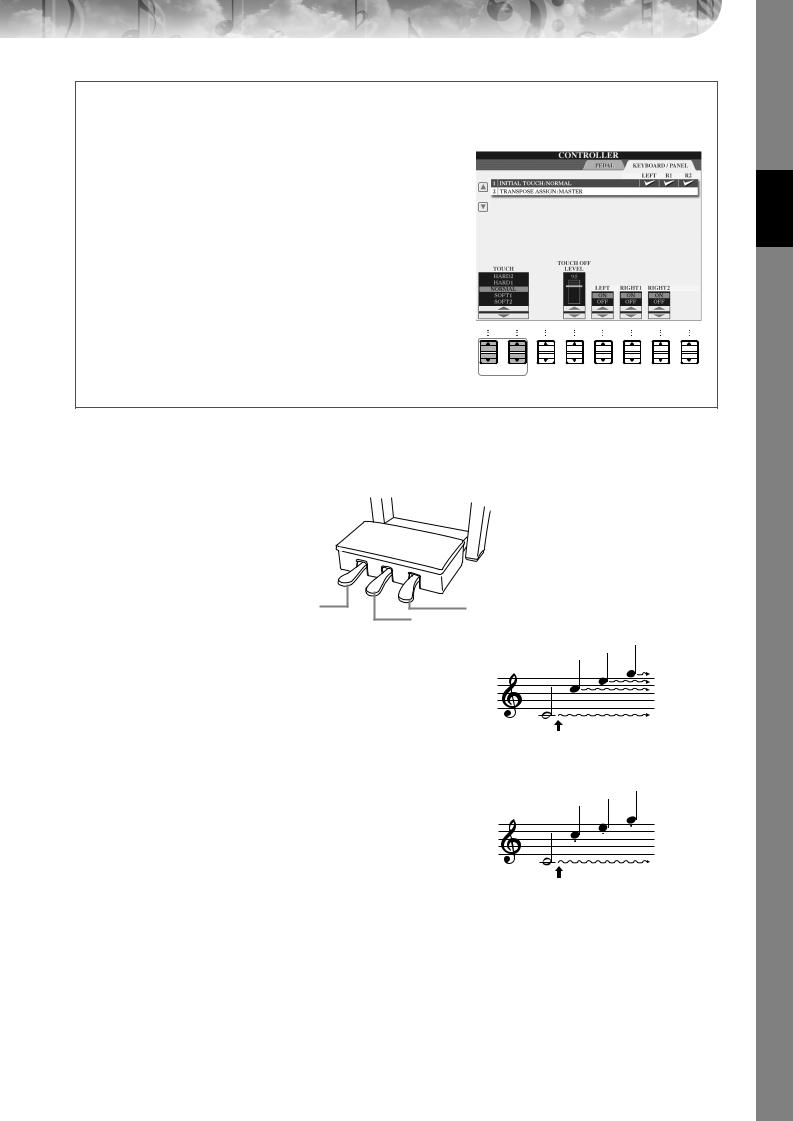
Setting the touch sensitivity of the keyboard
You can adjust the touch response of the instrument (how the sound responds to the way you play the keys). The touch sensitivity type becomes the common setting for all Voices.
1Call up the operation display:
[FUNCTION] → [D] CONTROLLER → TAB [®] KEYBOARD/ PANEL → [A] 1 INITIAL TOUCH
2Press the [1π†]/[2π†] buttons to specify the touch response. HARD 2 ..... Requires strong playing to produce high volume. Best
for players with a heavy touch.
HARD 1 ..... Requires moderately strong playing for high volume. NORMAL... Standard touch response.
SOFT 1....... Produces high volume with moderate playing strength. SOFT 2....... Produces relatively high volume even with light play-
ing strength. Best for players with a light touch.
n • This setting does not change the weight of the keyboard.
• When you do not want to apply touch sensitivity, set Touch to OFF for
the corresponding parts by pressing the [5†]–[7†] buttons. When
1 2 3 4 5 6 7 8
Touch is set to OFF, you can specify the fixed volume level by pressing the [4π†] button.
Using the Pedals
The Clavinova features three pedals.
Left Pedal |
Damper Pedal |
|
Sostenuto Pedal |
● Damper Pedal (Right)
The damper pedal performs the same function as the damper pedal on an actual acoustic piano, letting you sustain the sound of the voices even after releasing the keys.
n• Some Voices may sound continuously or have a long decay after the notes have been released while the damper pedal is held.
•Certain Voices in the “PERCUSSION & DRUM KIT,” “GM&XG” and “GM2” groups may not be affected by use of the damper pedal.
When you press the damper pedal here, the notes you play before you release the pedal have a longer sustain.
● Sostenuto Pedal (Center)
If you play a note or chord on the keyboard and press the sostenuto pedal while holding the note(s), the notes will sustain as long as the pedal is held. All subsequent notes will not sustain.
n• Certain Voices, such as [STRINGS] or [BRASS], sustain continuously when the sostenuto pedal is pressed.
•Certain Voices in the “PERCUSSION & DRUM KIT”, “GM&XG” and “GM2” groups may not be affected by use of the sostenuto pedal.
When you press the sostenuto pedal here while holding the note(s), the notes will sustain as long as you hold the pedal.
● Left Pedal
When the Piano voice is selected, pressing this pedal reduces the volume and slightly changes the timbre of the notes you play.
The settings assigned to this pedal may differ depending on the selected Voice. n The depth of the left pedal effect can be adjusted (page 95).
Guide Quick
CVP-309/307 Owner’s Manual |
29 |
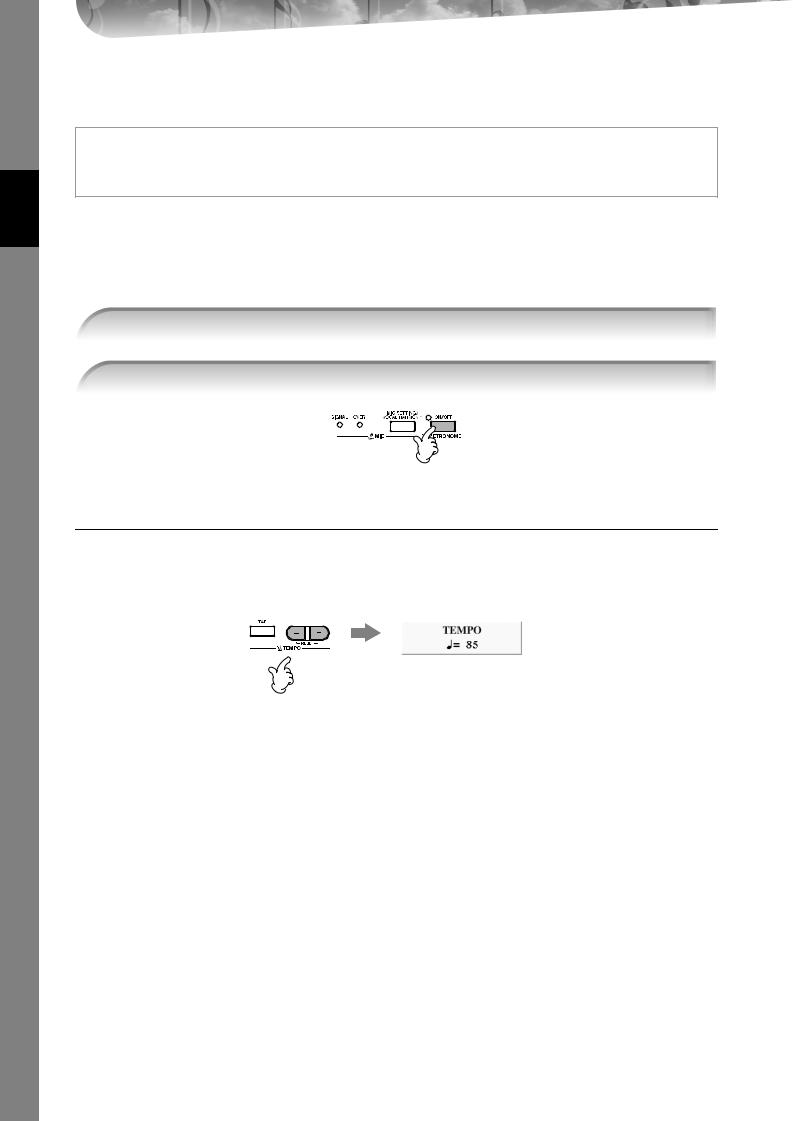
Quick Guide
● Foot Controller/Footswitch
An optional Yamaha foot controller (FC7) or footswitch (FC4 or FC5) can be connected to the AUX PEDAL jack and used to control various functions assigned (page 186).
Making Settings for the Pedals
You can assign one of the various functions to the three pedals or an optional foot controller/footswitch, doing things like starting and stopping the Style (page 186).
Using the Metronome
The metronome provides a click sound, giving you an accurate tempo guide when you practice, or letting you hear and check how a specific tempo sounds.
1 Press the METRONOME [ON/OFF] button to start the metronome.
2 To stop the metronome, press the METRONOME [ON/OFF] button again.
Adjusting the Tempo or Setting the Time Signature of the Metronome Sound
■ Adjusting the Metronome Tempo
1 Press the TEMPO [–]/[+] button to call up the pop-up tempo setting display.
2Press the TEMPO [–]/[+] buttons to set the tempo.
Pressing and holding either button lets you continuously increase or decrease the value.
You can also use the [DATA ENTRY] dial to adjust the value. To reset the tempo, press the TEMPO [–]/[+] buttons simultaneously.
nAbout the Tempo display
The number in the display indicates how many quarter-note beats there are in one minute. The range is between 5 and 500. The higher the value, the faster the tempo.
3Press the [EXIT] button to close the Tempo display.
■Determine the Metronome Time Signature and Other Settings
1Call up the operation display:
[FUNCTION] → [I] UTILITY → TAB [√] CONFIG 1 → [B] 2 METRONOME
30 |
CVP-309/307 Owner’s Manual |
